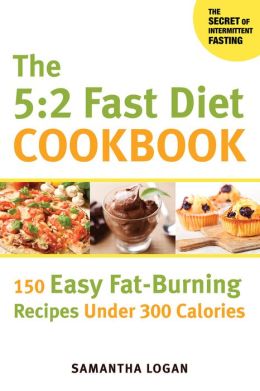 The 5:2 Fast Diet Cookbook by Samantha Logan is just that, a cookbook. If you’re not familiar with the popular 5:2 fasting diet craze, you won’t find much supporting information in this book to guide you, but you will find 150 low-calorie healthy recipes to supplement the program. The author created the cookbook after she adopted an intermittent fasting lifestyle and lost 30 pounds.
The 5:2 Fast Diet Cookbook by Samantha Logan is just that, a cookbook. If you’re not familiar with the popular 5:2 fasting diet craze, you won’t find much supporting information in this book to guide you, but you will find 150 low-calorie healthy recipes to supplement the program. The author created the cookbook after she adopted an intermittent fasting lifestyle and lost 30 pounds.
The 5:2 fasting diet mentioned in this book and countless others on the market is based on the principle that intermittent fasting, “actually helps you reset your metabolism and rev up your body’s fat-burning ability.” On the diet, men and women are asked to restrict their calorie consumption on two nonconsecutive days per week and then eat as they normally would on the other five. On non-fasting days if the dieter wants to eat high calorie foods the author advises them to, “Go for it,” but then later encourages people to, “Make smart food choices,” so the takeaway is a bit vague.
While the author bears no credentials, it’s disappointing that she didn’t go the extra mile to describe the diet in more detail or provide statements from a doctor, nutritionist or registered dietitian regarding the efficacy of the program or the scientific data behind it.
What The 5:2 Fast Diet Cookbook lacks in well-researched clinical information, it makes up for in healthy recipes. The book offers 150 meal ideas, all under 300 calories. Categories range from breakfast fare, to soup, salad, lean meats and desserts. The book even includes a chapter on low-cal vegetarian dishes. The recipes are chock-full of fruits, vegetables, whole grains and other healthy options. To stave off boredom, the author includes more than just pantry staples, suggesting ingredients like Calimyrna figs, muenster cheese, Herbs de Provence and lemongrass chili paste, to name a few.
Though the recipes in the book are all under 300 calories, I still found it hard to believe the author’s assertion that a person could easily eat three meals on a fasting day. Women are restricted to 500 calories per day and men to 600. Though it’s not an impossibility to choose three meals that wouldn’t break the calorie bank, I found that most days would allow only for two meals. Bear in mind, the brain needs about 500 calories a day to fuel basic functions, and most dietitians would advise against consuming less than 1200 calories a day. Unfortunately, there are no helpful hints as to what the dieter should do if he/she feels hungry on fasting day, not even the encouragement to drink more water, which seems like basic advice.
Overall, I found The 5:2 Fast Diet Cookbook to be hastily written and incomplete. I wish the author had included more substantial information on the diet itself. On a positive note, I found the recipes themselves to be creative, healthy and with enough variety that people interested in low-calorie cooking will have several meals to choose from. While fasting diets continue to bring criticism and support on both sides of the argument, the recipes in this book will be beneficial for anyone who wants to cook with better health in mind.
Also Read:
The Dangers of Juice Fasting for Quick Weight Loss
